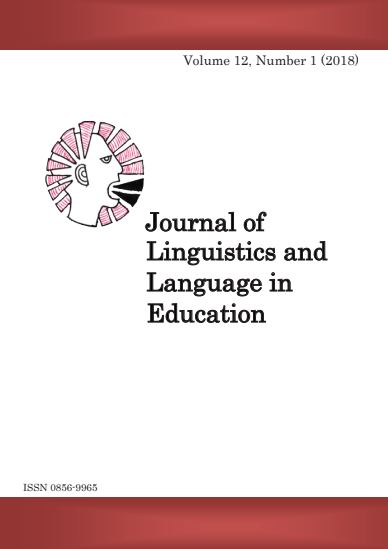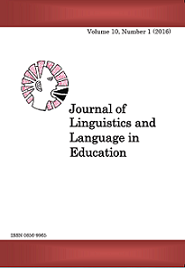A Syntactico-semantic Analysis of Possessive Constructions in Kisubi
Abstract
This paper intends to explore the way in which possessive constructions in Kisubi can be categorised and examine the extent to which semantic line between the established possessive categories is clearly demarcated. The study is guided by the prototype theory and it is confined to the nominal possessive constructions. It adopted a qualitative approach. Data were collected from six (6) participants who were snowballingly selected from three wards in Biharamulo District. The data were collected using structured interview, introspection and focus group discussion (FGD). Content analysis technique and interlinear glossing approach were used for data analysis. The Prototype Theory was mainly used in categorising possessive constructions. The findings indicate that possessive constructions fall into two broad categories, namely typical and less typical. Typical possessive constructions (TPCs), also known as alienable possessive constructions, display actual/canonical possession. Less typical possessive constructions (LTPCs) on the other hand can be divided into two categories: firstly, inalienable possessive constructions, which essentially display socio-cultural possession; and secondly, neitheralienable-nor-inalienable possessive constructions. The latter category has three aspects: generic possessive constructions, part-whole-like possessive constructions and other-relations possessive constructions. The findings of the study demonstrate that there is a thin line between alienable and inalienable possessive constructions: the semantic features of both categories tend to overlap in some occurrences.
Key words: alienable, inalienable, prototype theory, possessive constructions, possessor, possessee, typical and less typical, concept
References
Alexiadou, A., Haegeman, L. & Stavrou, M. (2007), Noun Phrase in
the Generative Perspective. Berlin: Walter de Gyuyter GmbH
& Co.
Austin, J. L. (1960). How to do things with Words. Cambridge-Mass: Harvard University Press.
Chandra, P. Kumar, R. (2012). Alienable-inalienable Possession
Distinctions: From Syntax to Semantics. Indian Linguistics,
(1 €“4): 35 €“45.
Den Dikken, M. (2006). Relators and Linkers, MIT Press.
Dobler, E. (2008). The Morpho-phonology of (in)alienable Possession, The Proceedings of the 2008 Annual Conference of the
Canadian Linguistic Association.
Ethnologue. (2013). Languages of the World.
Freitas, H., Oliveira, M., Jenkins, M. & Popjoy, O. (1998). The Focus Group, a Qualitative Research Method: Reviewing the Theory and Providing Guidelines to its Planning. ISRC Working
Papers, 22.
Gebregziabher, K. (2012), The Alienable-inalienable Asymmetry:
Evidence from Tigrinya. In R. M. Michael et al. (eds.). Selected Proceedings of the 42nd Annual Conference on African
Linguistics. Somerville, MA: Cascadilla Proceedings Project:
€“182.
Guéron, J. (2006a). Inalienable Possession, In M. Everaert & H. van Riemsdijk (eds.). The Blackwell Companion to Syntax, 2, 589 €“638, Boston/Oxford: Blackwell.
Guthrie, M. (1967-71).Comparative Bantu: An Introduction to
Comparative Linguistics and the Prehistory of the Bantu Languages, 4, Farnborough: Gregg Press.
Helmbrecht, J. (2016), NP-internal Possessive Constructions in
HoocÄ…k and other Siouan Languages. In c. Rudin & B. J.
Gordon (eds.). Advances in the Study of Siouan Languages
and Linguistics. Berlin: Language Science Press: 425 €“463.
Ingle, J. (2013). The Bamunka Noun Phrase. SIL, Yaoundé: Ministry of Scientific Research and Innovation.
Langacker, R. W. (2000). Grammar and Conceptualization. Berlin
and New York: Mouton de Gruyter.
Lyons, J. (1997). Semantics II, Cambridge: Cambridge University
Press.
Maho, J. F. (1999). A Comparative Study of Bantu Noun Classes,
Orientalia et Africana Gothoburgensia, 13, Göteborg: Acta
Universitatis Gothoburgensis
Matambirofa, F. (2000). Some Aspects of the Architecture of the
Possessive Noun Phrase in Bantu. Zambezia, XXVII (I), University of Zimbabwe.
Mugane, J. M. (1997). A Paradigmatic Grammar of Gikuyu.
Stanford: CSLI Publications
Newman, P. & Ratliff, M. (eds.) (2001). Linguistic Fieldwork.
Cambridge: Cambridge University Press.
Nkumbulwa, J. (2015). Endangered African Proverbs Collections:
Subi (Tanzania) Proverbs. Retrieved from www.afriprovorg/bibliography/373-endangered-african-proverbs-collectionssubi-tanzania-proverbs-html
Payne, T. E. (1997). Describing Morphosyntax: A Guide for Field
Linguistics. London: Cambridge University Press.
Radford, A. (2004). Minimalist Syntax: Exploring the Structure of
English. New York: Cambridge University Press.
Rosch, E. (1999). Reclaiming Cognition: The Primacy of Action,
Intention and Emotion: The Journal of Consciousness Studies,
(11 €“12): 61 €“77.
Rugemalira, J. M. & Muzale, H. R. T. (2008). Researching and
Documenting the Languages of Tanzania. Language Documentation and Conservation, 2(1) Tanzania: LOT Project: 68 €“108.
Sager, J. C. (1990). A Practical Course in Terminology Processing.
Amsterdam: John Benjamin Publishing Company.
Syal, D. V. & Jindal, D. V. (2007). An Introduction to Linguistics:
Language, Grammar and Semantics. New Delhi: Prentice
Hall.
Vergnaud, J. & Zubizarreta, M. (1992). The Definite Determiner and the Inalienable Constructions in French and English.
Linguistic Inquiry, 23: 595 €“652.
Downloads
Published
Issue
Section
License
Copyright © by Department of Foreign Languages and Linguistics, University of Dar es Salaam
All rights reserved. No part of this publication may be reproduced or transmitted in any form or by any means, electronic or mechanical, including photocopying, recording, or any information storage or retrieval system, without permission in writing from the publisher, except for short extracts in fair dealing, for research or private study, critical scholarly review or discourse with an acknowledgement.



